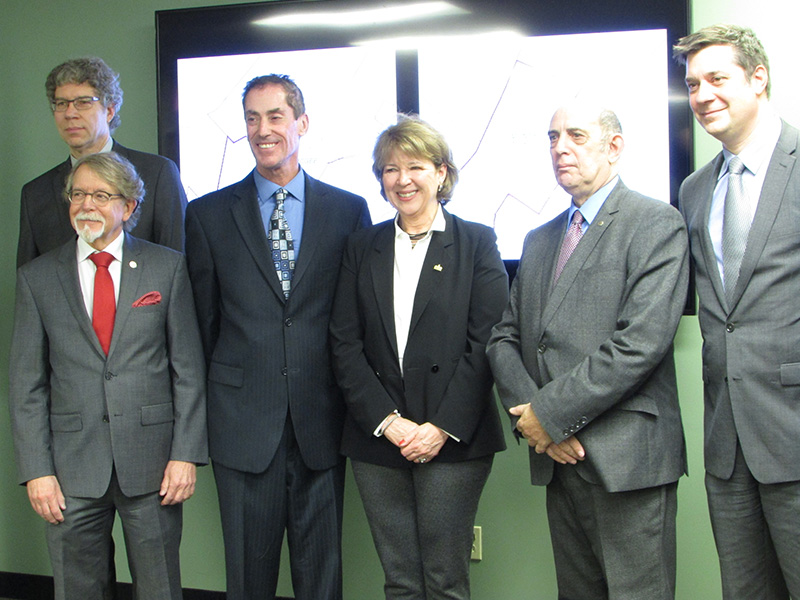Quebec’s newly revised electoral map should be challenged in court, say elected officials from the city’s west end, because it diminishes the political rights of minorities in particular, as well as the representation of Montreal overall.
The municipal and borough mayors of Côte St. Luc, Hampstead, Town of Mount Royal, Côte des Neiges-Notre Dame de Grâce (CDN-NDG), and Outremont have banded together to fight the revisions, but they say it is up to citizens to take legal action.
READ: AT-RISK GROUPS GET MORE SECURITY FUNDING IN FEDERAL BUDGET
At a press conference at the CDN-NDG borough office on March 16, Hampstead Mayor William Steinberg said he believes changes finalized by the province’s chief electoral officer on March 2 are contrary to the Canadian and Quebec charters of rights and freedoms.
“This is an absolute disaster of an electoral map,” said Steinberg, whose town is in the D’Arcy-McGee riding.
The main objection is to the merger of the Mont Royal and Outremont ridings, which eliminates a seat on the Island of Montreal and creates a new riding with a larger-than-average population. The reconfiguration also results in a significant expansion of neighbouring D’Arcy-McGee to include an area with far fewer Jewish and anglophone voters, and leaves about half of Outremont’s chassidic community on the other side of Mercier riding’s new border.
Côte St. Luc Mayor Mitchell Brownstein said his city is unique in being home to such a high concentration of Jewish voters, as well as many anglophones and ethnic groups. “They had stronger voices when D’Arcy-McGee had reasonable borders. Those voices are now diluted,” he said.
“The issue goes beyond just this electoral map,” said Steinberg. “For decades now, rural ridings have been gaining more electoral power than urban ridings. That is discriminatory; it should have changed ages ago, but Quebec has chosen not to.”
READ: JEWISH GROUPS ALARMED AS MORE ANTI-JEWISH SERMONS FOUND IN MOSQUES
The reason, he charged, is that rural ridings are primarily white, francophone and Catholic, while minorities live mostly in cities.
CDN-NDG Coun. Marvin Rotrand, who chaired the conference, said the Island of Montreal has lost at least one seat in every revision since 1992 (for a total of four), even though its population has increased.
The electoral map is reviewed by the independent Commission de la representation electorale du Québec after every other provincial election. By law, the total number of ridings in the province cannot exceed the current 125.
The mayors distributed a 55-page legal opinion by Université de Montréal dean of law Jean-François Gaudreault-DesBiens, which sets out 12 grounds on which the revised map could be legally contested.
Rotrand said he is still “recovering from a sense of shock” over commission chair Pierre Reid’s final report, which is an about-face from the assurances made in the Feb. 7 interim report. The commission wrote at that time that it had been persuaded by the arguments from citizens, municipalities and community groups against the fusion of Mont Royal and Outremont and moving the boundaries of D’Arcy-McGee and Mercier.
The process of revision began two years ago with public consultations following the commission’s tabling of its first report making those recommendations.
The mayors say they have received no explanation from the commission for its abrupt reversal.
Besides disrupting “natural” communities, such as the Jews, anglophones and Filipinos, Rotrand said the changes ignore the fact that the population is increasing in Mont Royal and Outremont, and is projected to continue to grow with new housing developments.
Moreover, the elected officials pointed out that six ridings outside Montreal have populations lower than the prescribed median by a margin of more than 25 per cent. They suggest Quebec adopt a law like Manitoba’s where the deviation cannot be more than 10 per cent, plus or minus. Currently, voter populations in 55 of its 57 ridings are, in fact, within 5 per cent, they say.
New Brunswick’s electoral law also specifically protects linguistic minorities, Steinberg pointed out.
CDN-NDG borough Mayor Russell Copeman said it would be inappropriate and impractical for municipalities to go to court against a provincial agency.
He said this is a matter that touches citizens directly and, furthermore, it would mean asking taxpayers to foot the bill for “one public body taking judicial recourse against another public body, and that is not in the best interest of the population.”
Rotrand said the municipal officials’ role at this point is to provide information to the public and support any initiative in this direction.
The average number of voters per riding is set at 48,952, with an allowance of 25 per cent either way, meaning the maximum is 61,190 and the minimum is 36,714.
The new D’Arcy-McGee and Mont Royal-Outremont will have between 55,000 and 59,000 voters each by the 2018 election, while several regional ridings are in the 37,000-40,000 range, and six have fewer voters than the legal minimum.
